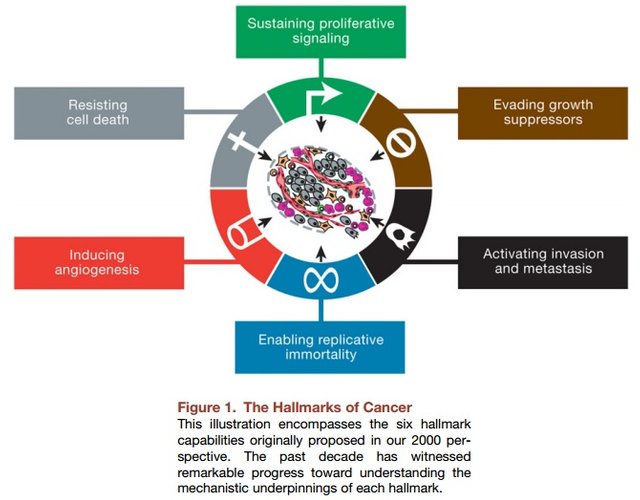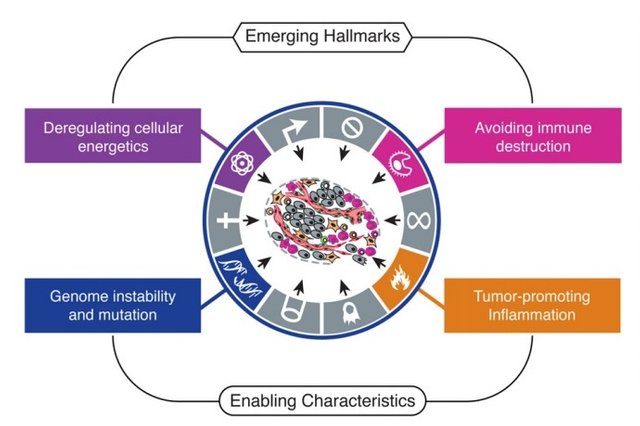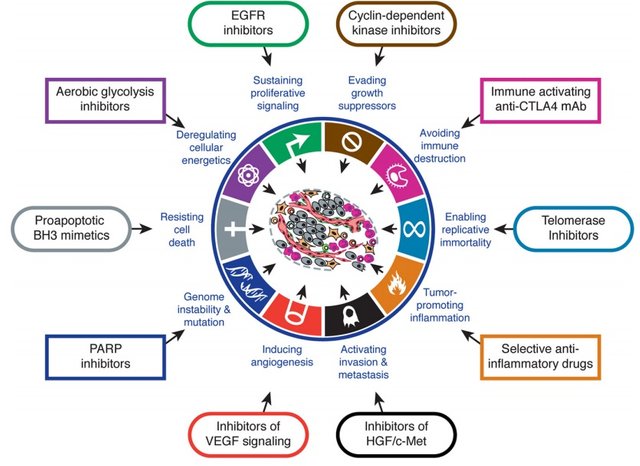The 8 Hallmarks of Cancers
Each cancer has a unique genetic fingerprint. This is why we may not have been able to find a 'cure-all' approach as of yet.
You keep hearing simplistic explanations from wannabe-experts, you keep hearing about the surprising plant from the back of your garden that could cure cancer, you keep hearing the media hyping about a new treatment...
Most of that is baloney, surface-level non-sense often preached by people who do not know better and even more often preached with intentional deception.
The hard truth is that cancers are extremely complicated. I use the plural to emphasize the uniqueness of each.
But even though each cancer is unique from a genomics standpoint, there are a few similarities among most forms of cancer.
Douglas Hanahan and Robert Weinberg are two researchers who published two papers on cancer, one in 2000 and an updated version of it in 2011. The papers, highly 'technical', are under the title:
Together, they have been cited for more than 40,000 times since their publishing date. And that is a huge accomplishment for a scientific paper. They discuss similarities among cancers.
In this post I'm going to give my interpretation to their findings...
The Hallmarks of Cancers
I wrote in more detail about these papers on my personal blog, but here I'm going to try to present a less 'technical' perspective.
In their first paper from 2000, Hanahan and Weinberg note that there are:
"six biological capabilities acquired during the multistep development of human tumors."

These 6 hallmarks are:
- Sustaining Proliferative Signaling
- Evading Growth Suppressors
- Resisting Cell Death
- Enabling Replicative Immortality
- Inducing Angiogenesis
- Activating Invasion and Metastasis
Tumor promoting inflammation, genome instability, and mutations underlie these hallmarks. Technological advances and the wealth of research in cancer have added two emerging hallmarks to this list:
- Reprogramming of Energy Metabolism
- Evading Immune Destruction

I'll go through each of them.
1. Sustaining Proliferative Signaling
- one of the most fundamental characteristics of cancer cells
- cancer cells can do this in multiple ways:
According to Hanahan and Weinberg:
"They may produce growth factor ligands themselves, to which they can respond via the expression of cognate receptors, resulting in autocrine proliferative stimulation. Alternatively, cancer cells may send signals to stimulate normal cells within the supporting tumor-associated stroma, which reciprocate by supplying the cancer cells with various growth factors."
2. Evading Growth Suppressors
- normal cells do not undergo uncontrollable growth mostly due to tumor suppressors
- cancer cells evade the negative regulation of proliferation
3. Resisting Cell Death
- corrupted cells normally undergo processes like autophagy, apoptosis and necrophagy. Hanahan and Weinberg best explain this:
"The autophagic program enables cells to break down cellular organelles, such as ribosomes and mitochondria, allowing the resulting catabolites to be recycled and thus used for biosynthesis and energy metabolism."
In cancer, this mechanism is hijacked:
- During treatment (radiation therapy, nutrient starvation, chemotherapy and other cytotoxic drugs), stressed cancer cells shrink via autophagy. They undergo a state of reversible dormancy.
- Reversible dormancy allows them to re-grow after cancer treatment has been stopped.
4. Enabling Replicative Immortality
- to grow into large tumors, cancer cells required unlimited replication capabilities. Two normal cellular mechanisms are bypassed in order for this to happen: senescence and crisis (cell death).
5. Inducing Angiogenesis
- angiogenesis - development of new blood vessels
- to proliferate, cancer cells increase angiogenesis:
- Higher provision of nutrients and oxygen
- Increased capability of CO2 and waste disposal
6. Activating Invasion and Metastasis
As pointed by Hanahan and Weinberg, invasion and metastasis usually occur in the following way:
- Invasion of local tissue
- Invasion into nearby vessels (blood and lymph)
- Transit through blood and lymph
- Escape into other tissues
- Formation of micro-metastases (nodules of cancer cells)
- Growth into macroscopic tumors
Reversible dormancy and two other emerging hallmarks come in support of metastasis:
- reprogramming of energy metabolism
- evasion from immune destruction.
7. Reprogramming Energy Metabolism
- unlike normal cells, cancer cells favor glycolysis even in the presence of oxygen
- increased glycolysis => higher oncogene activation (RAS, MYC) and the possibility of existence of more mutations in tumor suppressors like P53.
Additionally, hypoxia (low oxygen environment) can increase glucose dependence, as has been seen in different tumors. With hypoxia more glucose transporters and enzymes related to glycolysis are upregulated.
8. Evading Immune Destruction
According to Hanahan and Weinberg:
"The long-standing theory of immune surveillance proposes that cells and tissues are constantly monitored by an ever-alert immune system, and that such immune surveillance is responsible for recognizing and eliminating the vast majority of incipient cancer cells and thus nascent tumors."
- When primary tumors are formed, their stroma supports a microenvironment for cancer cells
- Cancer cells invade the blood and lymph and travel to distant tissues and organs
- They are faced with a normal microenvironment
- Cancer cells and stromal cells interact in the new environment
- Support is developed for cancer cell colonization of the new site.
Some Considerations
If you have the knowledge and take the time to go through these papers in detail, you realize how 'reductionist' is to approach cancer treatment with standalone strategies:
- chemotherapy alone
- radiation alone
- hyperbaric oxygen therapy alone
- diet alone
- etc.
It would make more sense to use these and other strategies in conjunction. Hanahan and Weinberg provide a representation of the current and the proposed approach to deal with one or more of the 8 hallmarks:

Researchers are careful to point out that a therapy for one hallmark may not be efficient enough to eradicate all cancer cells:
"allowing some cancer cells to survive with residual function until they or their progeny eventually adapt to the selective pressure imposed by the therapy being applied."
This is the sort of adaptation that cancers can acquire through:
- mutations
- remodeling of the stromal microenvironment
- epigenetic reprogramming.
These adaptations can lead to cancer cells being able to reestablish their functional capacity; hence growing back into macroscopic tumors, thus relapse. This type of adaptive resistance could be avoided if all pathways that support one marker are targeted (with the interventions from above).
Ending Thoughts
If you've made it this far, I know that the 'picture' presented is not one of the most optimistic. Cancers are extremely complex. Yet, Hanahan and Weinberg end their 2011 paper in a positive note:
"Looking ahead, we envision significant advances during the coming decade in our understanding of invasion and metastasis. Similarly, the role of aerobic glycolysis in malignant growth will be elucidated, including a resolution of whether this metabolic reprogramming is a discrete capability separable from the core hallmark of chronically sustained proliferation. We remain perplexed as to whether immune surveillance is a barrier that virtually all tumors must circumvent, or only an idiosyncrasy of an especially immunogenic subset of them; this issue too will be resolved in one way or another."
They said this in 2011, but much progress has been made since then, especially within the fields of:
- genomics (sequencing capabilities, better and more accurate interpretation)
- genomic engineering with CRISPR/Cas9
- immunotherapy (gained traction circa 2013)
- imaging technologies (ability to detect cancers early on)
- metabolomics
- and many other fields of technology and research.
Hanahan and Weinberg should then do another amazing job by cramping decades of research into a very compact scientific paper - a 2016 updated version. Afterall, they have received great recognition in this field of research.
To stay in touch, follow @cristi
Credits for Images: Hanahan and Weinberg 2011
Cristi Vlad, Self-Experimenter and Author
Thanks for sharing these pieces of information. I learned a lot.
From my experience of someone close having a cancer, options for therapies are now used in conjunction (at least sometimes and somewhere since my statistical sample only contains a single person). This was of course maybe not the case in 2011.
is your closest one being given an individualized approach?
Yes she was followed closely and individually (at least it looked like, since there is no way to know that precisely).
well, that is good. slowly, but surely, things seem to move into a better direction.
Another very professional and informative article.
(and I just try to pick up some steem by grabbing Snapping Turtles by the throat)
Keep it up, and thanks for dropping my name a few times in the chat rooms. I appreciate that.
Best wishes on this one and your upcoming posts as well!
I enjoy what you put out there so I'm going to keep on sharing that! :) thanks for the feedback.
What do you think about the Cancer Genome Atlas? It has certainly revealed the staggering randomness and difficulty in defeating cancers. It seems like cancers don't share common mutational patterns between individuals, or even within the same individual for that matter.
I've been exploring TCGA a couple of months ago. the library is vast, it is a wealth of research data, mutations are found in multiple gene, but I think you see that some genes are more mutated than others:
I really hope they can keep making gains in the fight against cancer. The human body is so complex it is unreal.
it takes one step at a time
Informative post. How much of cancer do you think could be avoided through better diet and nutrition?
prevention is another thing. I think that lifestyle plays an important part. I may write about that too...
Please do.
One of the most interesting papers I've seen recently is about the anti-correlations between cancers (plural) and neurodegenerative disorders.
http://www.ncbi.nlm.nih.gov/pubmed/26354001
thank you! I'll have to take a look!
Very nice run down of this topic. The conversation you are having here (that there is no cure-all for cancer) is one I have to have quite regularly. Biology is so mind bogglingly complex, and the general populations understanding fairly basic. It's easy to understand why they would fall prey to the poor journalistic interpretations and general misinformation about cancer treatments. Rundowns like this do a monumental amount of good IMO.
thanks for the feedback @justtryme90. It should be to nobody's surprise that most media does not do indepth coverage of research and they focus on surface level stuff that catches the attention of the public. afterall, they're in it for profit, not necessarily for good spread of knowledge. the victims? the uneducated average Joe who falls for it...
I like to give journalists the benefit of the doubt when it comes to a lot of scientific reporting. I think they themselves just don't have the basic scientific knowledge base to research things deeply enough to report on what they are told to write about. This is where posts such as yours can have the monumental benefit, they raise everyone's understanding. From those writing the generalized articles, to those reading them. :)
I hope you dont get the wrong impression of me saying that 'all journalists write like shit'. there are great ones, of course, but they are rare. they are 'la creme', as @lemouth might call them...
No, I didn't infer that, I was just contributing my take on the situation is all.
Would you consider cannabis ingestion a part of "diet" to suppress cancer growth? Or as another treatment category? Thanks.